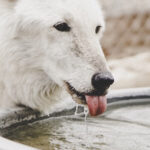Introducing a second dog to your household should be done gradually, allowing the dogs to get to know each other in a controlled and safe environment. Consider the temperament and energy level of both dogs to ensure a compatible match.
Also, provide separate spaces and resources for each dog to prevent competition and potential conflict. Welcoming a new furry friend into your home can be a joyous yet challenging experience for both the dogs and their owners. Successfully introducing a second dog requires careful planning and thoughtful consideration of the existing dog’s needs and the compatibility of the new addition.
By following a structured and patient approach, you can create a harmonious environment where both dogs can thrive. In this guide, we’ll explore the important steps and strategies to ensure a smooth and successful integration of a new dog into your household.

Credit: www.wisconsindesignerdoodles.com
Benefits Of Adding A Second Dog
Adding a second dog to your household can bring several benefits, such as providing companionship for your current pet, promoting increased physical activity, and enhancing overall socialization skills for both dogs. When introducing a new dog, it’s crucial to consider factors like temperament, space, and proper training to ensure a smooth transition.
Benefits of Adding a Second Dog Introducing a second dog to your household comes with a multitude of benefits that can enhance the lives of both the new addition and your existing furry family member. From providing companionship and socialization to an increase in exercise and mental stimulation, the decision to bring home a second dog can significantly enrich your everyday life.
Companionship And Socialization
Having another dog in the house provides built-in companionship for your existing pet. Their constant presence can alleviate feelings of loneliness and boredom, ensuring your pets always have a playmate to interact with. Aside from companionship, a second dog can aid in socialization by teaching your existing dog proper canine etiquette and behavior.
Increased Exercise And Mental Stimulation
The presence of a second dog in the household often results in more opportunities for exercise. From playful chasing games to regular walks, both dogs will benefit from the enhanced physical activity. In addition, the mental stimulation derived from interacting with another dog can combat boredom and provide mental engagement. Introducing a second dog to your household can be a rewarding experience for both you and your pets. It’s essential to consider the benefits that a new furry family member can provide before making the decision.

Credit: www.techsmith.com
Factors To Consider Before Getting A Second Dog
When considering adding a second dog to your household, there are several important factors to take into account. These considerations will help ensure a smooth and harmonious introduction for both your current and new canine companions. Before taking the leap, it’s crucial to evaluate the compatibility with your existing dog, available space and resources, time and commitment, and financial considerations.
Compatibility With Existing Dog
Before bringing home a new furry friend, it’s essential to assess how well your current dog will mingle with the potential addition. Consider factors such as age, size, temperament, and energy level of both dogs to determine their compatibility and potential for a successful coexistence.
Available Space And Resources
Adequate space and resources are vital when accommodating a second dog. Ensure your home has enough room for both dogs to live and play comfortably. Additionally, consider the availability of food, water, bedding, and separate feeding areas to prevent competition and conflicts over resources.
Time And Commitment
Integrating a second dog into your household requires a significant investment of time and commitment. Be prepared to dedicate time for training, exercise, and individual attention for each dog. Consider how you will manage walks, playtime, and socialization to meet the needs of both dogs.
Financial Considerations
Introducing a second dog also comes with financial implications. Ensure you are prepared for the additional costs of food, grooming, veterinary care, and unexpected medical expenses. Budget for vaccinations, regular check-ups, and potential behavioral training to provide the best care for both dogs.
Preparing Your Home And Existing Dog For A New Arrival
Preparing your home and existing dog for a new arrival involves creating a safe space, gradual introductions, and uninterrupted bonding time. Establishing a consistent routine and ensuring your current dog feels secure and loved can ease the transition. Gradually introducing the new dog in neutral territory can also help foster a positive relationship between the two pets.
Creating Separate Spaces When preparing your home and existing dog for the arrival of a new furry friend, it’s important to create separate spaces for each of them. This will help to prevent any territorial issues and provide a sense of security for both dogs. One approach is to set up a separate area in your home for the new dog, using a baby gate or other barrier to establish a designated space. This will allow them to become familiar with their surroundings without feeling overwhelmed. Additionally, make sure each dog has their own bed, toys, and food bowls in their respective areas. Gradual Introduction and Scent Exchange Introducing your existing dog to the new arrival should be done gradually, allowing them to become acquainted at their own pace. Start by exchanging scents between the dogs, such as swapping bedding or toys, to get them familiar with each other’s scent. Next, you can proceed with visual introduction through a barrier, such as a crate or a baby gate. This will allow the dogs to see and smell each other without direct contact, which prevents any potential aggression or fear. Positive Reinforcement and Training Positive reinforcement is key when introducing a second dog into your household. Praise and reward your dogs for calm and positive interactions, such as sniffing or wagging their tails. This will encourage them to associate the presence of the other dog with positive experiences. Additionally, provide training sessions for both dogs separately and together. This will help them establish boundaries and understand each other’s behaviors. Use treats, praise, and consistent commands to reinforce good behavior and discourage any negative behavior. Monitoring and Supervision During the initial stages of introducing a second dog, it’s vital to closely monitor their interactions to ensure a smooth transition. Keep a close eye on their body language, such as stiffening or growling, as this may indicate tension. Engaging in parallel activities, such as walking or playing, can help divert any potential conflicts. Supervision is crucial, especially during meal times or when sharing toys. Separate feeding areas and provide individual toys to avoid any resource guarding issues. Always be present during these interactions until you are confident that the dogs can coexist peacefully without any conflicts. By creating separate spaces, facilitating gradual introductions, using positive reinforcement, and maintaining vigilant supervision, you can ensure a successful integration of a second dog into your household. Taking these steps will help create a harmonious environment where both dogs can thrive and enjoy each other’s company.
Introducing The Dogs: Step-by-step Process
Looking to add another furry friend to your household? The Dogs Guide provides a step-by-step process to smoothly introduce a second dog to your home.
Introducing a second dog to your household can be an exciting but delicate process. To ensure a smooth transition, it’s essential to follow a step-by-step approach. By gradually introducing the dogs to each other in a controlled environment, you can promote positive interactions and reduce the risk of conflicts. In this guide, we will walk you through the step-by-step process of introducing your new dog to your existing furry family member, ensuring a harmonious and happy household dynamic.
Neutral Territory Meeting
One of the first critical steps in introducing your new dog to your current furry friend is to arrange a neutral territory meeting. This means selecting a location neither dog has claimed as their own, minimizing any territorial disputes that may arise. A local park or a neighbor’s fenced backyard can serve as a suitable neutral space. When introducing the dogs in this neutral territory:
• Keep both dogs on a leash and ensure they remain under control.
• Allow them to sniff and interact with each other, but monitor their body language closely.
• Observe their behavior for any signs of aggression or tension, such as raised hackles or growling.
• If both dogs show signs of comfort and curiosity, it’s a positive indicator that a relationship may develop.
• On the other hand, if any signs of hostility or fear are observed, separate them and try again later.
• Gradually increase the duration of these meetings, ensuring that both dogs remain under control and stress-free.
Controlled On-leash Introduction
Once both dogs have become acquainted in the neutral territory, the next step is to proceed with a controlled on-leash introduction. This phase allows the dogs to interact more personally while still maintaining control and preventing any potential confrontations. To conduct a controlled on-leash introduction:
• Choose a controlled and confined area, such as a large room or backyard, where the dogs can interact.
• Keep both dogs on separate leashes and maintain a safe distance between them initially.
• Allow them to sniff and observe each other’s body language without tension or restraint.
• If the dogs remain calm and relaxed, gradually decrease the distance between them.
• Continue monitoring their behavior and respond assertively if any aggression is displayed.
• Repeat these on-leash introductions several times, gradually increasing the amount of time the dogs spend together.
Off-leash Introduction Under Supervision
Once the dogs have demonstrated compatibility during on-leash introductions, it’s time to progress to off-leash interactions under close supervision. This stage allows the dogs to interact more naturally and freely. However, careful observation is still crucial to ensure their safety and prevent any potential conflicts. During off-leash introductions:
• Select a secure and enclosed space, such as a backyard, to minimize any potential escape risks.
• Remove both dogs’ leashes and provide ample space for them to explore and interact.
• Continue closely supervising their interactions, stepping in if necessary to prevent any aggressive behavior.
• Gradually increase the duration of off-leash interactions, always being mindful of their behavior.
• Remember that supervision should always be present until you are confident in the dogs’ ability to coexist peacefully.
Monitoring And Adjustments
Finally, even after the initial introductions and successful interactions, it’s crucial to monitor the dogs’ behavior and make any necessary adjustments to ensure ongoing harmony. Dogs, like humans, may encounter occasional misunderstandings or conflicts. By remaining observant and proactive, you can prevent potential escalating issues and maintain a positive and peaceful environment for both your dogs. Key points to consider during monitoring and adjustments:
• Continue observing their behavior during shared activities, such as meal times or play sessions.
• Identify and address any signs of resource guarding or territorial behavior promptly.
• Implement consistent and fair training techniques for both dogs to build a strong foundation.
• Seek professional help from a dog trainer or behaviorist if needed, to address any persistent issues.
• Ensure you provide equal attention, affection, and exercise to both dogs to prevent any feelings of jealousy or imbalance. By following this step-by-step process and prioritizing your dogs’ safety and well-being, you can successfully introduce a second dog to your household. With patience, consistency, and vigilance, your furry friends are more likely to develop a positive bond and enjoy a harmonious companionship in their shared home.
Managing And Nurturing The Relationship Between Dogs
This guide offers valuable insights on how to introduce a second dog into your household, providing practical tips and strategies to manage and nurture the relationship between your furry companions. Learn effective techniques to ensure a smooth and harmonious transition for all members of your canine family.
Managing and nurturing the relationship between dogs is crucial when introducing a second dog to your household. By following a few key guidelines, you can ensure a harmonious and balanced dynamic within your pack. Fair and equal treatment, ensuring individual bonding time, addressing behavioral issues, and building a strong pack dynamic are all important factors to consider. Fair and Equal Treatment: One of the main foundations to a successful relationship between dogs is fair and equal treatment. Dogs have a keen sense of fairness, so it’s essential to distribute attention, treats, and affection equally between your dogs. This will prevent jealousy and rivalry from developing and maintain a sense of balance within the pack. Ensuring Individual Bonding Time: Each dog in your household deserves individual bonding time with both you and their fellow canine companion. This allows them to build unique connections and strengthen their bond with each member of the pack. Schedule separate playtime, walks, and training sessions to give each dog the special attention they need and deserve. Addressing Behavioral Issues: When introducing a new dog, it’s important to address any behavioral issues promptly and effectively. Keep an eye out for signs of aggression, possessiveness, or resource guarding and address these issues with professional help if needed. Consistent training and positive reinforcement techniques can go a long way in promoting good behavior and preventing conflicts between dogs. Building a Strong Pack Dynamic: To foster a strong pack dynamic, it’s vital to establish clear leadership and hierarchy within your household. Consistency in routines, rules, and expectations will help your dogs understand their place in the pack. Encourage positive interactions and reward cooperative behavior to reinforce the group’s unity. In conclusion, managing and nurturing the relationship between dogs requires fair and equal treatment, ensuring individual bonding time, addressing behavioral issues, and building a strong pack dynamic. By following these guidelines, you can create a harmonious and balanced environment for your dogs, promoting a healthy and loving relationship between them.
Common Challenges And Troubleshooting Tips
Introducing a second dog to your household can be challenging, but with these troubleshooting tips, you can ensure a smoother transition for both dogs. Learn how to manage common issues and create a harmonious environment for your canine companions.
Sibling Rivalry And Competition
Introducing a second dog to your household can sometimes lead to sibling rivalry and competition. As each dog tries to establish their place within the pack, conflicts can arise. To address this issue, it is important to provide a calm and structured environment for both dogs to coexist harmoniously. Here are some troubleshooting tips to tackle sibling rivalry and competition: 1. Training Sessions: Engage both dogs in separate training sessions to reinforce commands and establish boundaries. This helps them to understand their roles and reduces the chances of conflicts. 2. Equal Attention: Make sure to give equal attention, love, and affection to both dogs. This reduces the chances of one dog feeling left out or becoming jealous. 3. Supervised Playtime: During the initial stages of introducing the second dog, it’s crucial to supervise their playtime. Intervene when necessary and redirect their focus onto toys or other positive distractions. 4. Separate Feeding Areas: To prevent resource guarding, provide each dog with their own separate feeding area. This ensures that both dogs have equal access to food and reduces the likelihood of food-related conflicts. 5. Structured Walks: Take both dogs for structured walks together, ensuring that they are walking side by side without any aggressive behavior. This helps to establish a sense of unity and harmony during outdoor activities.
Resource Guarding And Jealousy
Resource guarding and jealousy can arise when one dog feels the need to protect its possessions from the other. This can include food, toys, or even human attention. It is crucial to address these issues to prevent any potential conflicts. Here are some troubleshooting tips to overcome resource guarding and jealousy: 1. Positive Reinforcement: Reward both dogs simultaneously for calm and non-aggressive behavior around resources. This helps to eliminate any negative associations with sharing and promotes a positive environment. 2. Individual Attention: Spend quality time with each dog individually to ensure they feel valued and loved. This reduces the chances of jealousy and promotes a healthy relationship between you and your furry friends. 3. Gradual Introduction: When introducing a new toy or treat, allow both dogs to sniff and explore it together. This helps them associate the new item with positive experiences and reduces the chances of guarding behavior. 4. Preventing Conflict: Keep valuable resources out of sight and reach when the dogs are together. This reduces the likelihood of jealousy and resource guarding.
Establishing A Hierarchy
Establishing a hierarchy is crucial when introducing a second dog to your household. Dogs are pack animals and naturally seek a sense of order and structure. By establishing a clear hierarchy, you can minimize conflicts and create a balanced environment for both dogs to thrive. Here are some troubleshooting tips for establishing a hierarchy: 1. Consistent Rules: Set consistent rules and boundaries for both dogs and ensure that everyone in the household follows them. This helps to establish a sense of order and clarity. 2. Feeding Order: Determine a feeding order and make sure both dogs understand the sequence. This reinforces the hierarchy and prevents any food-related conflicts. 3. Separate Sleeping Areas: Assign separate sleeping areas for each dog to prevent any potential turf wars. This allows them to have their own space and reduces the chances of dominance-related issues. 4. Structured Interactions: Take charge during interactions between the dogs, especially during initial introductions. This helps establish your role as the pack leader and promotes a sense of calm and order.
Separation Anxiety And Bonding Issues
When introducing a second dog, separation anxiety and bonding issues can arise. Dogs may feel anxious when separated from each other and struggle to form a strong bond. Addressing these issues is essential to ensure the emotional well-being of both dogs. Here are some troubleshooting tips for separation anxiety and bonding issues: 1. Gradual Separation: Gradually expose the dogs to short periods of separation, starting with just a few minutes and gradually increasing the time apart. This helps them become more comfortable being alone and reduces distress. 2. Individual Attention: Spend quality one-on-one time with each dog to strengthen the bond between you and them. This helps them feel secure and loved, reducing separation anxiety. 3. Positive Reinforcement: Use positive reinforcement techniques when the dogs show calm behavior even when separated. This helps them associate positive experiences with being apart. 4. Shared Activities: Engage the dogs in shared activities such as playtime, walks, and training sessions. This promotes bonding and creates positive associations with each other’s presence. Remember that every dog is unique, and it may take time for them to adjust to each other’s presence. By providing a structured and supportive environment, you can overcome common challenges and create a harmonious household for your furry companions.

Credit: www.thepuppyacademy.com
Frequently Asked Questions For Guide To Introducing A Second Dog To Your Household
How Do I Introduce A Second Dog To My House?
Introducing a second dog to your house requires careful steps for a smooth transition. Start with a neutral area and supervised meetings. Gradually increase their time together while keeping their separate spaces. Monitor their behavior for any signs of aggression or stress.
Seek professional guidance if needed.
What Is The 3 3 3 Rule For Dogs?
The 3 3 3 rule for dogs is a training technique that involves taking the dog out for a 3-minute walk, then allowing it to sniff for 3 minutes, followed by 3 minutes of playtime. This helps to provide mental stimulation and physical exercise for the dog.
When Should I Add A Second Dog To My Family?
Consider adding a second dog when your current one is well-trained and social, and if you have the time, resources, and space to accommodate another pet. It’s essential to consider the personalities and compatibility of both dogs before making this decision.
How Long Does It Take For Two Dogs To Get Used To Each Other?
It can take anywhere from a few days to a few weeks for two dogs to get used to each other. The time frame depends on their individual temperaments and how well they are introduced and socialized.
Conclusion
Introducing a second dog to your household can be a rewarding experience with the right approach. By properly preparing your home, carefully selecting a compatible dog, and gradually introducing them to each other, you can create a harmonious environment for both dogs to thrive.
Remember to give them time to adjust and establish their own routines. With patience, consistency, and love, you can successfully integrate a new furry friend into your family.





